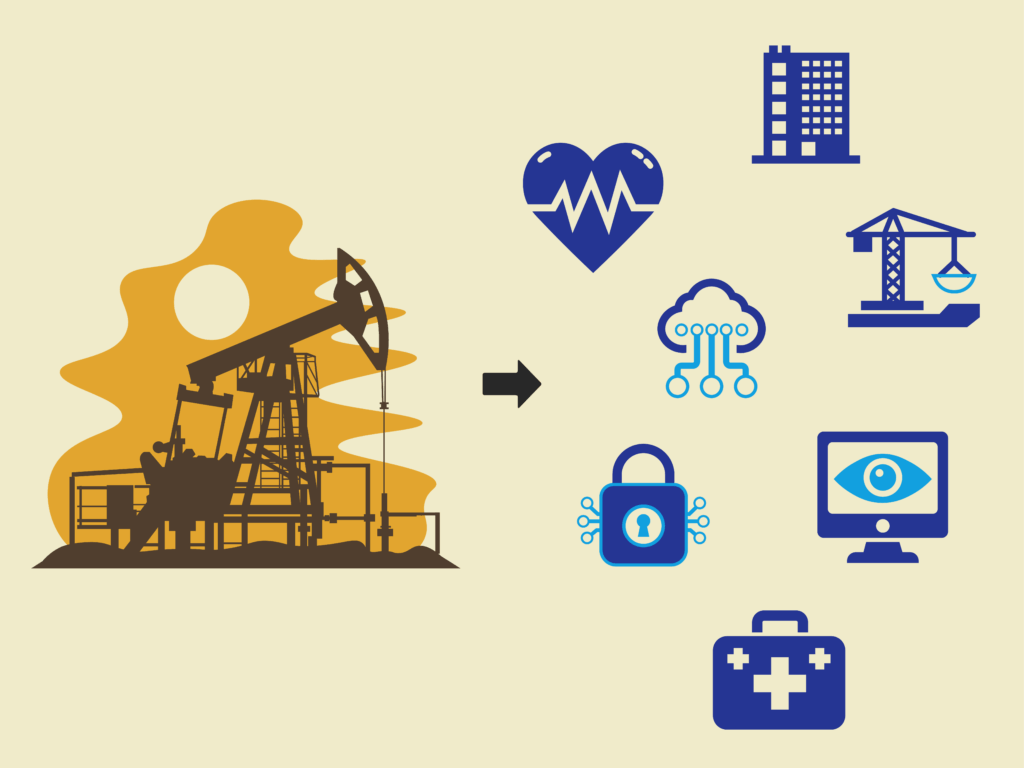
The Future Isn’t Now (But It Soon Will Be)

Caribou Honig co-created Insuretech Connect last year, the largest insurance technology conference of 2016. He has been a venture capitalist for several years and has a keen interest in insurtech. He will be leaving QED Investors, a firm he co-founded, later this year to devote more time to insurance technology and education. We recently sat down with him in his Old Town office in Alexandria, Virginia.—Editor
Many years ago, my folks were driving up to Quebec, and they stopped overnight in the town of Caribou in northern Maine, where I’m told they grow a lot of potatoes and there is a weather station and that’s about it.
And this being a road trip, I was named after the town in which I was conceived. The standard joke is that I’m lucky not to be named Buick.
I think you’ve got some bits and pieces of that being applied to underwriting. I’ve seen only a little bit on the product side. So as I think about the insurance value chain, I’ve got my distribution, my marketing, I’ve got my product, I’ve got my underwriting.
The product side is actually where I see the greatest opportunity to change the game, to create bigger transformation. And when you change product, then marketing, distribution and underwriting have to change with it. We’re only now starting to see a handful of companies going after the product side.
And there’s a lot of analogies between that and the lending side.
We’ve leaned into the fintech side of things, and not surprisingly over the course of years we’ve seen and made a few investments related to insurtech. In the same way, back in 2009, 2010, when we were doing fintech before fintech was cool, we were doing a few insurtech deals before insurtech was a thing.
Our first was in 2011. We were a part of the seed funding round for Drive Factor, an automotive telematics provider. I feel in hindsight we were probably a little early. We not only made an investment but actually had a successful exit.
Drive Factor was ultimately bought by CCC in April 2015. CCC is in the claim service side for auto. And what I really like about that is the notion that telematics provides you with information about what the driver is doing, what the car is doing, and then CCC has information on what happens when it comes to claims and incidents. You put those two things together and I think it’s a much more powerful offering for a carrier than either one of them. That’s real synergy.
Other investments were TransUnion, Valen Analytics and a company called L2C.
A company called Pitzi in Brazil, which has a cell phone insurance company, is similar to Asurion. A company in Germany called KNIP is kind of a digital mobile broker. We also recently invested in a company in Mexico in the aggregator space called ComparaGuru.
We’ve invested across every stage. We’ve done a couple of seed deals. We’ve done a couple of private-equity stage deals, like TransUnion.
Series A, where a company has a little bit of traction in the market but isn’t necessarily scaled up, tends to be our sweet spot. I tell entrepreneurs, “I need to see 500 customers for six months if it’s a B2C business.”
And then I have enough to go on. Less than that, earlier than that, is really hard for me to get conviction about what’s going to happen. We write modest-sized checks—$1 million to $5 million over the life of an investment.
The mindset of a VC is very simple. It is this constant balance between fear and greed. You’ve got the fear devil on one side and the greed angel on the other shoulder, and we’re always balancing that. An investment always starts with a great entrepreneur, great management.
You know, you can look at everyone’s darling today, Uber. There’s a lot of elegance to what they are doing. Yes, they are eating the lunch of an incumbent—the taxi industry. But they are creating lots of value—clear preference among many consumers. They’re also creating lots of value for a bunch of drivers and enough value left over for Uber shareholders to get handsomely rewarded. So that sort of elegant value creation is transformative and a disruptive business model.
Uber started by solving a problem for black cars, and then once they started to get real traction, they realized this gives us a foothold into not just the black car market but into the general taxi market. Oh, that just happens to be 100 times bigger. It’s OK if the initial market you’re tackling is somewhat niche as long as that can lead somewhere.
And I’ll say, insurance is fascinating in that regard. There are, of course, the giant categories led by auto, homeowners, health, life. But then the deeper I dig, the more fascinated I am finding niches of insurance.
Did you stumble upon insurtech?
I prefer the word “serendipity” over “stumble.” If you build a reputation for being very focused on data-driven companies and for actually knowing a thing or two about financial services, people start to think, oh, maybe you’ll fit this insurance-related data thing. It turns out, they were right, that we were sort of interested.
My job is to look around corners to see what’s coming. About two years ago, we saw insurtech was about to go through what I call its Cambrian explosion—a bunch of experiments, many of which natural selection would eventually prune away. It looked to us like the insurance industry is about five to 10 years behind the banking industry in adopting technology.
The web was a strong enough force to push banks into adopting technology because of their fundamental business, business processes and consumer-facing approach. Technology overcame the inertia of the banking industry, which has a fair bit of it.
But the Internet and the web were not actually sufficient—as far as I can tell—to overcome the immovable object of the insurance industry. I think in part because the insurance industry was actually doing pretty well. Insurance is pretty healthy and serving a lot of needs well.
The interactions people have with the industry are infrequent in comparison to banking, which has much higher frequency. It’s the difference between toothpaste and a dentist. Banking is much more your toothpaste.
So there’s more appetite for things that will reduce the friction.
In insurance, even if the user interface to finding out about my policy is pretty inconvenient and circa 1997, I only have to go there a couple of times a year, so it’s just not that costly. People’s expectations around interactivity—around their ability to engage on demand—is convenience. And that is sort of taken to a new level with the smartphone.
There’s a whole cascade of technologies that are riding on the smartphone’s coattails that open up new possibilities for the industry. Drones are one of my favorite examples. Drones would not exist in their form without the advances that cascade from building a billion smartphones a year. You get this mass investment in small battery technology, in lightweight processing power, in cameras—all of which cascade down into drones.
The lower cost curve and the greater functional ability to operate them makes them a more viable solution for claims and maybe underwriting. That takes costs out of the system. So you’ve got both a demand side and supply side driving this new change.
We’ve heard a lot about behavioral economics recently. How does that fit in?
You can incorporate behavioral economics into your user interface and then into some aspects of your business model, all with the existing technology.
I’m impressed that Lemonade is embracing behavioral economics. I think that it is a robust field with many applications in insurance. There’s empirical data, for instance, around different ways you can reduce fraud or quasi-fraud. You see it manifested throughout the experience that Lemonade puts in front of the consumer, like the “Honesty Pledge.”
Those things, again, don’t necessarily require a sophisticated next-gen-tech stack, right? Although, they do work a lot better if it’s through a direct channel rather than through an agent. It’s really hard to apply behavioral economics through middlemen, because you don’t control the interaction precisely enough.
A lot of good marketing. I think for a while people talked about the peer-to-peer piece of it. I think that’s not quite a smoke screen, but it’s a piece of behavioral economics. I think the Lemonade team put it out there and then the tech press bit. They previously saw all the peer-to-peer stuff happening in lending, like Lending Club and Prosper. They got excited and said peer-to-peer is going to reinvent insurance just like peer-to-peer is reinventing lending. But I don’t think the Lemonade team drank their own Kool-Aid. I suspect they would say, “Well, look, if that’s what’s going to get us our great seed round funding, then terrific. We’ll take it.”
But of course it’s not inconsistent with their strategy of applying behavioral economics to insurance. It’s part of that. But it’s not “the thing” that defines Lemonade.
I want to start with a framework—my view of what a technology-driven innovation will look like. The hallmarks of technology-driven change are three things: a reduction in friction, an increase in transparency and lower costs.
When you have technology coming to bear in the value chain, it’s creating quantification and metrics around that part of the value chain. I can take cost out of the system by seeing where my costs are. That’s the transparency. I can then apply technology to pull out friction and therefore pull out cost.
I think there are still a lot of carriers who aren’t even using regression models. So I think for some carriers, 2003 is still calling. With the exception of a handful of sophisticated insurers, particularly auto insurers, there wasn’t a lot of use of sophisticated statistical models. The truth is people stopped using the term “big data” in part because there aren’t actually many cases of really big data
That said, some insurance use cases are legit big data use cases. Telematics—that’s real big data—large quantities, and it’s unstructured. That’s a really good place to look at machine learning.
I think drone data, image data, lends itself to real machine learning. Think about using SnapSheet to grab a picture of your recent auto accident and avoid having an adjuster come out to see your car. I think that’s an area where technology can give you the twin benefits of a better end customer experience and cost savings for the carrier.
My sense is that there is a product for everyone. Every edge case, every sort of unusual commercial need, can find a policy ultimately. But it’s a vast collection of edge cases, which means you end up having a giant thorny matching problem, which gets solved by a fleet of human brokers doing that matching. But that ends up being more expensive, costlier to the system. It’s higher friction, slower, more frustrating than a technology-oriented matching system
So I will say it is less about the product side than it is around finding ways to make the matching more efficient.
One of the grand debates around this is, if you’re an entrepreneur trying to solve this matching problem, do you orient your business to enable brokers to more efficiently do the matching so that a team of 10 brokers, instead of being able to do N matches on behalf of clients—connecting them with carriers in a day, can do 2N or 3N?
So you quickly learn you don’t need 10 brokers anymore. You can get by with four, and their productivity can increase. This is ultimately good for them, good for the carriers and good for the clients, because the cost of four brokers is less than the cost of 10.
And there’s a question around how you divide up the spoils of greater efficiency. How much goes to the customer? How much to the carrier? How much to the broker? And don’t forget there’s a fourth party in this mix.
That technology provider also wants to get paid and capture some of the value they’re creating.
In the short term, the answer is going to be, the brokers who are first to adopt technology that makes them more productive will reap the gains, because the pricing and the commissions and everything facing the customer won’t change immediately.
I’m really intrigued. It feels a little bit like the New York Stock Exchange floor, right? Having a bunch of humans doing that matchmaking between buyers and sellers. I don’t understand why reinsurance brokering needs to and should be done by a fleet of humans. And you’ve got big commercial counterparties, right?
It’s not a distribution problem. It’s really almost a matchmaking problem in its purest form. So why do reinsurance brokers exist? Why is that not a tech-enabled digital marketplace? I think I’m starting to come across a few companies that are new startups that are tackling that. I’m too ignorant, still, to defend the incumbent case. If it’s ripe for the digital marketplace, then it’ll happen.
We’re still in the early days. Creative destruction is socially painful. Think about tens of thousands of people losing their jobs because technology is being brought to bear in their value chain and reducing the value of what they do. Think bank tellers. You don’t need as many bank tellers when you have ATMs. It’s cheaper. It’s more convenient. But socially, it’s always painful when that happens.
If you are a carrier and you’re worried about your existing agent distribution footprint retiring off, you still need to worry. You need to have your remaining producers pick up the slack. So if you’re a carrier and you’ve got 1,000 physical points of presence through your broker network and each one has two people in it and one of those people retires and the other person is still there, great—no problem as long as you have productivity taking up the slack. But if each one has one person and half of them are retiring, then you’ve gone from 1,000 points of presence to 500. That’s a bit more of an issue.
You could argue carriers need to play more of a role in nurturing and incubating the remaining agents and brokers in terms of driving them to recommended technology solutions for productivity and efficiency.
If I’m a carrier, do I ask myself, “Do I try to enable the existing brokers, or do I try to disintermediate the broker by becoming one myself?” I feel like I’ve seen almost a 50/50 split
One of my long-standing favorites out there is a company called Bold Penguin, out of Ohio. They are saying the existing small business commercial broker is going to persist. Many of them may retire, but as a structure they’re going to persist. It’s how people are still going to get most of their policies, and we want to equip them to do better. And we want to connect them with a bunch of carriers on our network.
There are also really good companies in this space that are trying to connect directly to the end client. Some of these are hybrid, where they may cooperate with a brokerage or they may serve some brokerage, as well. Bunker is a really good company. Embroker is another really good company.
We’re talking a few hundred being funded per year. And that’s probably up 100 from the year before. There is this wave of really early-stage companies that are now beginning to mature to where they are attracting Series A venture capital. You get a little bit of traction, a little bit of proof points.
You’re talking in the zip code of $1 billion to $2 billion of venture capital going into these companies. That’s enough to at least create some experimentation among the entrepreneurs. The dollars invested will grow more quickly as some of those early stage companies start to succeed. Then they’ll be able to attract bigger checks.
If you’re going from an entrepreneur PowerPoint deck to ringing the opening of the New York Stock Exchange in 10 years, that’s pretty quick. There aren’t very many overnight success stories. Even the ones that feel like they are were working at getting to some sort of scale before you ever knew about them five years ago.
Credit Karma is one of our investments. We led their Series A back in 2009. They talk publicly of having 60+ million users, now. And they started in 2007. So they’re nine years old.
People are talking about them as candidates for an IPO. I won’t comment on that. They’re certainly at an interesting scale. If you’re getting to IPO after 10 years, that’s a really good pace. If you’re faster than that, that’s blazing fast. There are plenty of great companies built over two decades.
You have folks like Axa and American Family and Liberty and so on that are not only trying to do some commercial partnerships but also trying to write investment checks. And they’ve lit up some in-house corporate venture capital, which I think is a perfectly reasonable way to invest. I’ve been, on the whole, quite impressed with their approach to venture capital.
One of the classic failings of in-house corporate venture capital is they try to serve two masters at once. They give lip service to the financial returns, but then they also very much link their investments to strategic goals. And serving two masters in that space is really hard. I think it’s a recipe for failure. I think carriers have been, on the whole, more disciplined about saying, “If we’re going to light up a VC capital arm in-house, we’re going to run it like a VC arm.”
I don’t think there was any single event. There were several factors at once. A lot of the fintech VCs had sort of played out the banking side. Lending, payments and wealth management were looking for the next sub-sector of fintech, broadly defined as financial services. And lo and behold, here is this utterly massive one which has had—compared to those other areas—a lot less investment and entrepreneurship.
A very high-quality crop of entrepreneurs jumped into the space. These things are perhaps a bit of an echo chamber, where people start talking about the opportunities in insurance, and that draws in some high-quality entrepreneurs, which then draws in more VCs. So you get these sorts of virtual cycles building.
The last thing that incubated the ecosystem was carriers and reinsurers. They have become—particularly in the last 19 months—really interested and willing to partner with high-quality startups. That’s a crucial piece for the success of these entrepreneurs.
We’re in the second inning. By comparison, I would say in fintech we’re in fourth and fifth innings. And in payments—PayPal—we’re in the sixth inning. I think we will see another wave of experimentation, of entrepreneurs being drawn and of capital becoming available. I think it is still on the upswing.
I think you’ll start to see some of the first wave of seed-stage insurtech companies start to get their next wave of funding, which will allow them to accelerate what they’re doing. What the next round of capital wants to see is traction after that first round. Once an entrepreneur shows they can deliver what they said they were going to deliver, and there’s some product market fit, then the VCs want them to just accelerate, accelerate, accelerate. They’ll give them some capital to do that.
I hope we’ll start to see some APIs [application programing interfaces, i.e., customer interfaces] across the value chain. I just saw the other day Liberty Mutual at least declaring they’re going to have open APIs available. I thought that was really interesting. That is actually very forward thinking. I think we’ll see more of that.
I also think drones have some real application in insurance. And you’ll start to see some sort of outsourced networks of drone operators. So I don’t need to own the drone. I just need access to a network—almost an Uber of drone operators.
I’m also keen on parametric insurance. So if traditional insurance is indemnity, if I have a loss I’m going to get covered for the amount of loss I actually incurred. Parametric is defined as if there’s a preset claim event, which is triggered by some objective third-party parameter. The classic is an earthquake of magnitude X within a latitude and longitude radius of where I am. Then there is a predetermined amount that will be paid out for that. Crop loss is another one. If the Department of Agriculture includes this acreage in its drought report, then there is a crop insurance payout.
And what I like about parametric compared to indemnity is it takes cost out of the system, because I don’t need underwriting in the same way. I don’t need to send someone on premises and do a bunch of measurements and gauging. There’s still some underwriting to understand the risk, but it’s not quite the same. The claims cost—adjudicating claims—should go to near zero, because I’m just getting some third-party data feed, as long as it’s a valid data feed.
And by the way, the Internet of things starts to open up more data feeds every day as the quantified earth happens. I love that it takes cost out of the system, because that’s fundamentally making the ecosystem better.
I think it can be a much better experience for the insured. If I’ve got some sort of loss event, the last thing I want is to wrangle with my carrier to get paid. I don’t want to be spending time documenting what just happened, setting up times to meet with the adjuster and so on and so forth.
Honig can be reached at [email protected].
Honig’s second Insuretech Connect conference will be Oct. 3-4 at Caesars Palace in Las Vegas. For information, visit www.insuretechconnect.com.




